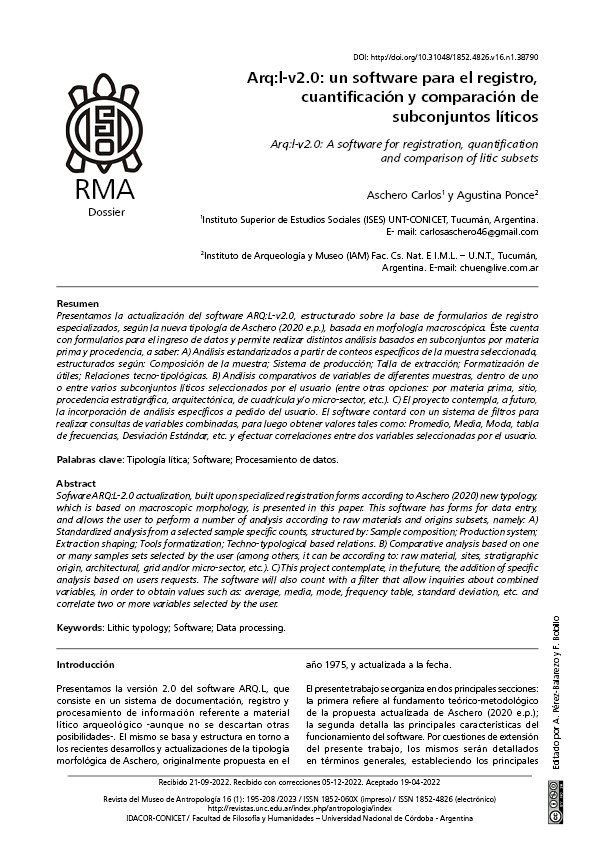Arq:l-v2.0: A software for registration, quantification and comparison of litic subsets
DOI:
https://doi.org/10.31048/1852.4826.v16.n1.38790Keywords:
Lithic typology, Software, Data processingAbstract
Sofware ARQ:L-2.0 actualization, built upon specialized registration forms according to Aschero (2020) new typology, which is based on macroscopic morphology, is presented in this paper. This software has forms for data entry, and allows the user to perform a number of analysis according to raw materials and origins subsets, namely: A) Standardized analysis from a selected sample specific counts, structured by: Sample composition; Production system; Extraction shaping; Tools formatization; Techno-typological based relations. B) Comparative analysis based on one or many samples sets selected by the user (among others, it can be according to: raw material, sites, stratigraphic origin, architectural, grid and/or micro-sector, etc.). C) This project contemplate, in the future, the addition of specific analysis based on users requests. The software will also count with a filter that allow inquiries about combined variables, in order to obtain values such as: average, media, mode, frequency table, standard deviation, etc. and correlate two or more variables selected by the user.
Downloads
References
Aschero, C.A. (1975). Ensayo para una clasificación morfológica de artefactos líticos aplicada a estudios tipológicos comparativos. Ms. Informe al CONICET, Buenos Aires.
Aschero, C.A. (1983). Revisión del Ensayo para una clasificación morfológica de artefactos líticos aplicada a estudios tipológicos comparativos. Apéndices A-C. Cátedra de Ergología y Tecnología; Facultad de Filosofía y Letras, Universidad Nacional de Buenos Aires. PrecIrculado interno de la cátedra.
Aschero, C.A. (2020). Una tipología morfológica-dimensional para artefactos de piedra tallada. En proceso de edición. A publicar en: http://institutoarqueologiaymuseo.org/
Aschero, C.A y S. Hocsman (2004). Revisando cuestiones tipológicas en torno a la clasificación de artefactos bifaciales. En: Temas de Arqueología. Análisis lítico, pags.7-25. Acosta. A., D.Loponte y M.Ramos compiladores. Departamento de Ciencias Sociales Universidad Nacional de Luján, Soc.Arg.de Antropología e Instituto de Antropología y Pensamiento Latinoamericano, Buenos Aires, 190 pags.
Bagolini, B. (1971). Ricerche sulla tipometría lítica dei complessi epipaleolitici della Valle dell’Adige. Prehistoria Alpina, vol.7:135-241. Rendiconti della Societá de Cultura Preistorica Tridentina, Trieste.
Boëda, E. (2020). Tecno-lógica & Tecnología. Una Paleo-historia de los objetos líticos cortantes. Bellaterra Arqueología, 271 págs. Barcelona.
Ericson, J. y B.Purdy (1984). Prehistoric Quarries and Lithic Production. En: New directions in Archaeology Series. Cambridge University Press. Cambridge.
Ingold, T. (2000). The Perception of the Environment. Essays on livehood, dwelling and skill.
Routledge, 265 págs. London and New York.
Mauss, M. (1964). Introducción a la Etnografía. Ediciones Istmo, 388 págs. Madrid.
Simondon, G. (1958). Du mode d’existence des objets techniques. Ed. Aubier, Paris.
Mera Paz, J. A. (2016). Análisis del proceso de pruebas de calidad de software. En: Ingeniería Solidaria, vol. 12, no. 20, pp. xx-xx. doi: http://dx.doi.org/10.16925/in.v12i20.1482

Downloads
Published
Issue
Section
License
Copyright (c) 2023 Carlos Aschero, Agustina Ponce

This work is licensed under a Creative Commons Attribution-NonCommercial-ShareAlike 4.0 International License.
Those authors who have publications with this Journalaccept the following terms:
a. Authors will retain their copyrights and guarantee the journal the right of first publication of their work, which will be simultaneously subject to the Creative Commons Attribution License (Licencia de reconocimiento de Creative Commons) that allows third parties to share the work as long as its author and his first publication in this journal.
b. Authors may adopt other non-exclusive licensing agreements for the distribution of the version of the published work (eg, deposit it in an institutional electronic file or publish it in a monographic volume) provided that the initial publication in this journal is indicated.
c. Authors are allowed and recommended to disseminate their work on the Internet (eg in institutional telematic archives or on their website) before and during the submission process, which can lead to interesting exchanges and increase citations of the published work. (See The Effect of Open Access - El efecto del acceso abierto)











